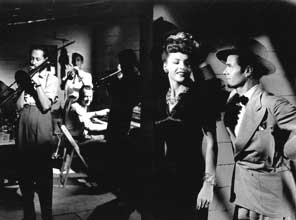
Robert Cumbow of the Parallax View blog has posted a very interesting article on film noir music scores discussing its origins, development, and major composers from the early noirs to recent neo-noirs:
The sound of noir—plaintive sax solos, blue cocktail piano, the wail of a distant trumpet through dark, wet alleyways, hot Latin beats oozing like a neon glow from the half-shuttered windows of forbidden nightspots. You walk the sidewalks of big, lonely towns, with no destination in mind, following only the sounds, guided by them, wondering where they come from, what hurt souls cry out with such tones.
Mr Cumbow also highlights CD compilations of note.

http://www.amazon.com/gp/product/B000QVCX1W/ref=dm_dp_trk15
I have always been enthralled by The Mask of Demetrios and now the sound tracvk for .89 as an mp3 download from Amazon along with scores of other downloads. How can I resist such a bargain? The music infectious and captivating and transoportive to the era and mood.
LikeLike
Hi! Tony,
On my website,(That is undergoing semi-reno(vation) not my blogs “mind you,” but of course not!…I features links to Jazz websites and the sites that focus on the Jazz connection to Film noir.
Personally, I Know people who can do without “Jazz” and the “Film noir connection.” and they have asked me not to “focus” on it!
But, then why do I focus
on it?
Because I know there are a lot people out there that like listening to that kind of music (Jazz music).
Dcd 😉
LikeLike
Then there’s always this little gem which also include great gobbets of dialogue in addition to the scores:
http://www.amazon.com/Murder-My-Beat-Classic-Themes/dp/B00123NWF4/ref=sr_f3_1?ie=UTF8&s=dmusic&qid=1239201579&sr=103-1
I bought it and loved it!
LikeLike
Hi! Tony,
Btw,
Below is a very interesting link to a site where author Eddie Muller, is discussing “Jazz, Film noir and Charlie Hayden (I may have “mispelled” his last name…
Haydn?!?)…among other things too!…I alway seems to
reference this article when the subject of Jazz and Film noir are mentioned in the same breath…Plus, this article is “featured” on my website, under what else?!? “Film Noir and Jazz Music”…Personally,
I find his (author Eddie Muller) “insight” about Jazz, film noir and S.F very interesting.
http://www.sfjazz.org/news/2006/2006_may_17.html
Dcd 😉
LikeLike
Oops!…I did mispell his last name…it is Haden…Charlie Haden’…
I’am so sorry about that!…
Dcd 😉
LikeLike
Thank you Edward, Dcd, and Jon for your comments and the noir music links.
LikeLike
http://www.sfjazz.org/news/2006/2006_may_17.html
Eddie Muller’s article is indeed interesting; thank you for the reference. The below quote relate jazz and 50’s noirs. Jazz was accepted experimentally. Miles Davis’ score was improvised for Elevator to the Gallows.
Q: Are there any threads you see connecting this particular half-dozen films and their soundtracks?
A: They’re all from the 1950s, when cultural changes and studio economics led to jazz being accepted, on a somewhat experimental basis, as viable for film scores. Jazz is an essential component of the films in this series, rather than being used to define one aspect of the mise-en-scene. As a group, these films disprove that jazz is ill-suited for film scores because of its improvisational nature. Miles Davis’s score for Elevator to the Gallows is largely improvised, but Ellington’s score for Anatomy of a Murder and John Lewis’s “third stream” score for Odds Against Tomorrow are tightly-composed. In general, and in these films specifically, jazz is used to evoke a mood rather than to manipulate the audience to feel a certain emotion. It takes confident directors to do that.
LikeLike
Great quote Edward! Thanks.
LikeLike
Hello all. Anybody here aware of the cd/album ‘Noiresque – The Lonely Fate Of The Femme Fatale’ by Sandra Lawrence. Songs of the femmes fatales. From such classics as ‘Affair In Trinidad’, ‘Dark City’, Miss Sadie Thompson’, ‘Gilda’, The Long Goodbye’, ‘The Blue Gardenia’ and ‘Affair In Trinidad’.
LikeLike